

Procurement and Supplier Management: The Ultimate Guide
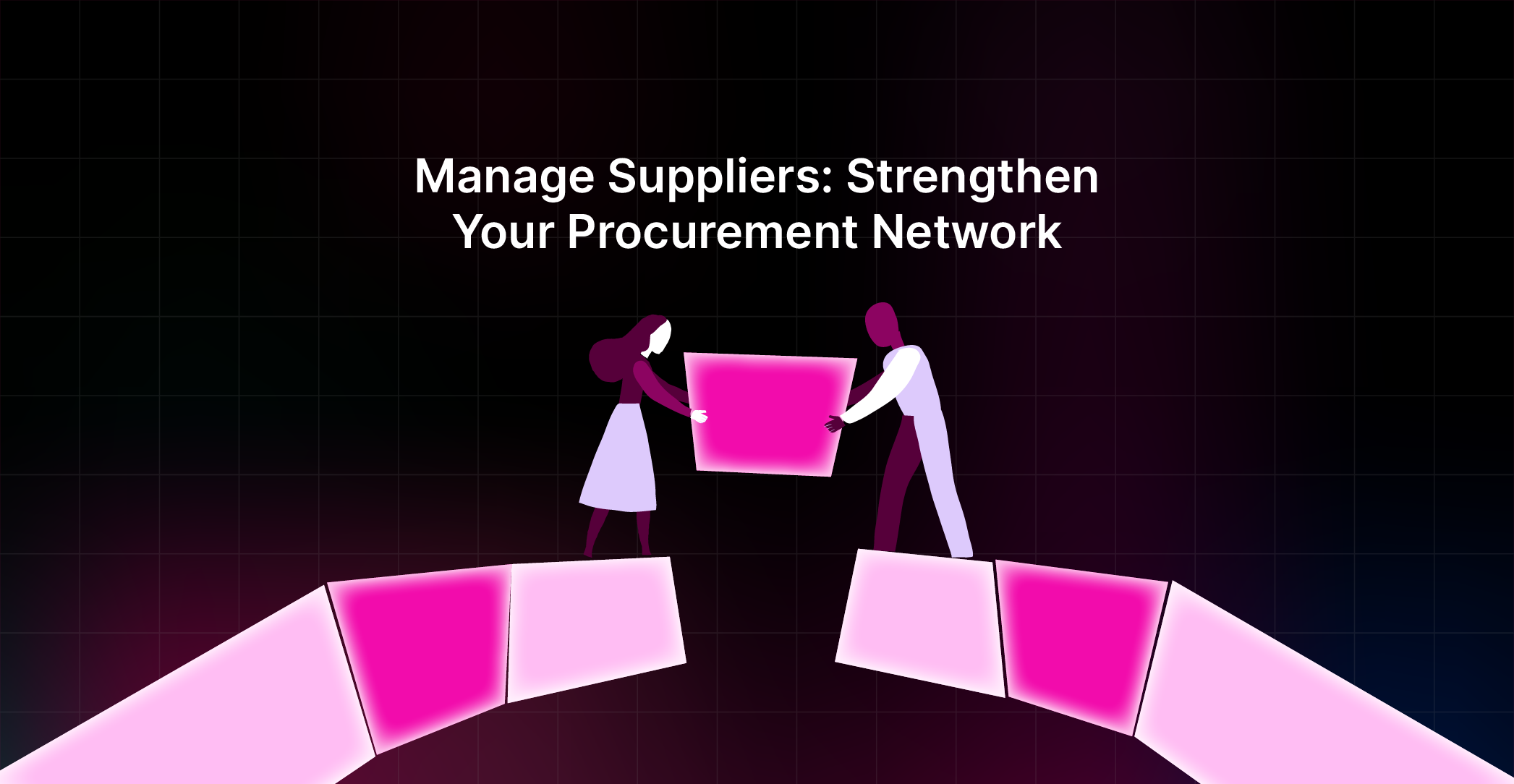
Procurement and Supplier Management: The Ultimate Guide
Explore best practices for procurement and supplier management in our ultimate guide.


Imagine this: Your company is rapidly expanding and taking on major new projects. Supply chain reliability is critical to delivering on time and on budget. You need to scale up procurement fast to support the growth, but your current processes and supplier relationships are disjointed and inefficient. Late deliveries and quality issues are impacting your projects.
Only, that's not what happens.
In this comprehensive guide, we'll dive deep into the key elements of effective procurement and supplier management. You'll learn best practices to optimize your supply chain, mitigate risks, and drive long-term value for your organization.
What is Procurement and Supplier Management in a nutshell?
Procurement and supplier management involve sourcing goods and services needed for business operations and maintaining vendor relationships. Procurement focuses on purchasing, while supplier management ensures collaboration, performance, and compliance. Together, they drive efficiency, cost control, and sustainable growth.
It involves a series of steps:
- Identifying business needs and requirements.
- Conducting market research and analyzing spend data.
- Developing sourcing strategies and selecting appropriate suppliers.
- Negotiating contracts and pricing agreements.
- Issuing purchase orders and managing the procure-to-pay process.
- Monitoring supplier performance and compliance.
Procurement goes beyond just buying things at the lowest price. It's about aligning purchases with business goals, mitigating supply risks, and creating value through strategic partnerships. Supplier management, on the other hand, is the systematic approach to assessing, selecting, onboarding, and continuously managing relationships with suppliers.
Key activities include:
- Segmenting suppliers based on strategic importance and risk.
- Establishing selection criteria and conducting due diligence.
- Integrating suppliers into company processes and systems.
- Setting performance expectations and service level agreements.
- Monitoring and rating supplier performance.
- Conducting periodic business reviews and providing feedback.
- Collaborating on improvement initiatives and innovations.
- Mitigating supply chain risks and ensuring business continuity.
The goal of supplier management is to maximize the value received from suppliers while minimizing risks. It's about building trust, transparency, and win-win relationships that support the company's long-term objectives.
Why Procurement and Supplier Management is Crucial for Enterprise Businesses
In today's competitive and volatile business environment, procurement and supplier management are more critical than ever. They directly impact a company's ability to deliver value to customers, stay profitable, and adapt to change. Consider these compelling reasons:
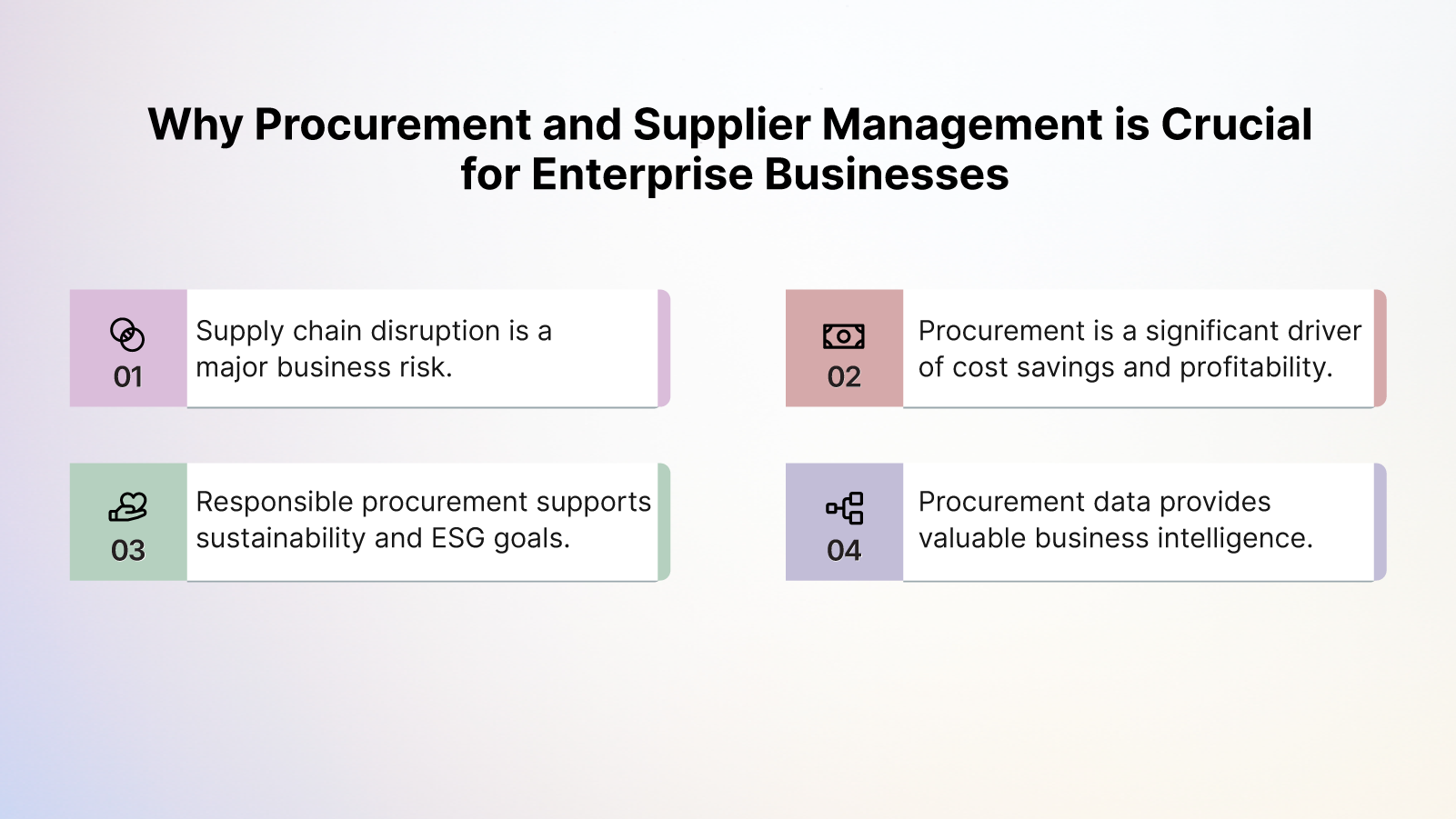
1. Supply chain disruption is a major business risk.
The COVID-19 pandemic exposed the fragility of global supply chains. Companies with robust procurement and supplier management practices were better positioned to weather the storm. They had visibility into their supply base, diversified sourcing options, and strong supplier relationships to prioritize their needs.
2. Procurement is a significant driver of cost savings and profitability.
For many companies, procurement accounts for over 50% of total costs. Even small percentage improvements can have a big impact on the bottom line. Strategic sourcing, supplier consolidation, and value engineering are powerful levers to reduce spend and improve margins.
3. Responsible procurement supports sustainability and ESG goals.
There is growing pressure from consumers, investors, and regulators for companies to manage their environmental and social impacts. Procurement plays a central role by sourcing sustainable materials, ensuring supplier compliance with ethical standards, and promoting diversity and inclusion in the supply base.
4. Procurement data provides valuable business intelligence.
The procurement function sits on a treasure trove of data about what the company buys, from whom, and at what prices. By analyzing spend patterns, supplier performance, and market trends, procurement can provide insights to guide strategic decisions, identify risks and opportunities, and optimize the supply chain.
To understand the complete differences between procurement & supply chain management, read "What Is The Difference Between Procurement and Supply Chain Management".
Types of Procurement Strategies
There is no one-size-fits-all approach to procurement. Companies use different strategies depending on the characteristics of the goods or services being purchased, the supply market dynamics, and the business objectives. Here are some common procurement strategies:
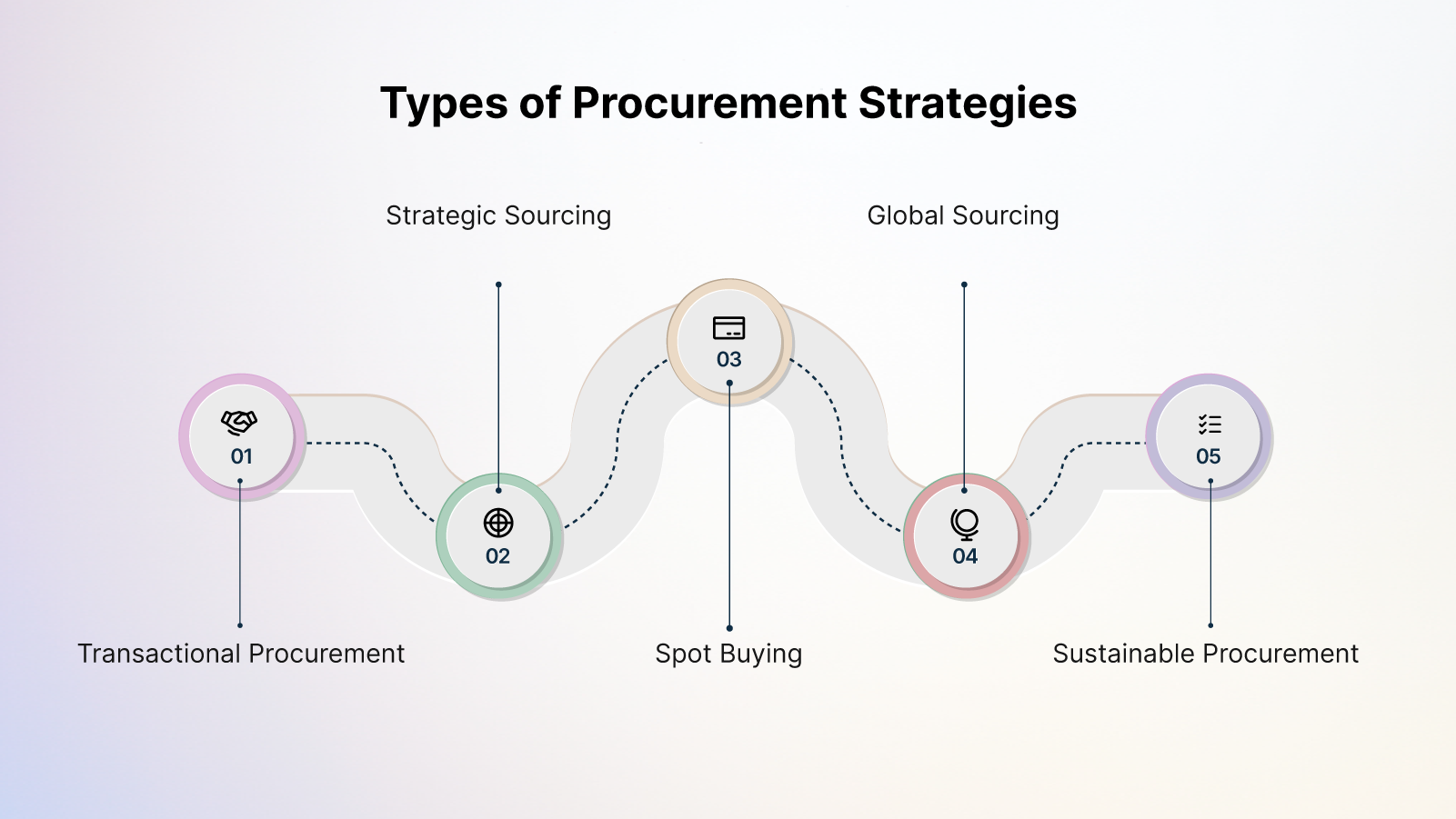
1. Transactional Procurement:
This is the traditional approach for low-value, low-risk purchases such as office supplies and maintenance items. The focus is on efficiency, with streamlined processes, pre-approved suppliers, and catalog buying.
2. Strategic Sourcing:
For high-value, high-risk categories that are critical to the business, a more strategic approach is needed. It involves in-depth market analysis, RFP processes, competitive bidding, and long-term contracts with preferred suppliers. The goal is to optimize total cost of ownership and mitigate supply risks.
3. Spot Buying:
For one-off purchases or unexpected demand spikes, spot buying allows companies to quickly source goods from the open market. The focus is on speed and flexibility, but it may come at a higher price.
4. Global Sourcing:
To take advantage of lower costs, specialized expertise, or scarce resources, companies may source from suppliers in different countries. This requires navigating complex logistics, regulations, and cultural differences. Strong supplier relationships and risk management are critical.
5. Sustainable Procurement:
With growing emphasis on corporate social responsibility, many companies are adopting sustainable procurement practices. This includes sourcing eco-friendly products, reducing waste and emissions in the supply chain, ensuring fair labor practices, and supporting diverse and local suppliers.
The most effective procurement organizations use a mix of strategies tailored to each category and aligned with overall business goals.
Importance of Supplier Management in Supply Chain Optimization
Suppliers are the lifeblood of any supply chain. They provide the raw materials, components, finished goods, and services that keep operations running smoothly. How well a company manages its suppliers can make the difference between a high-performing supply chain and a dysfunctional one.
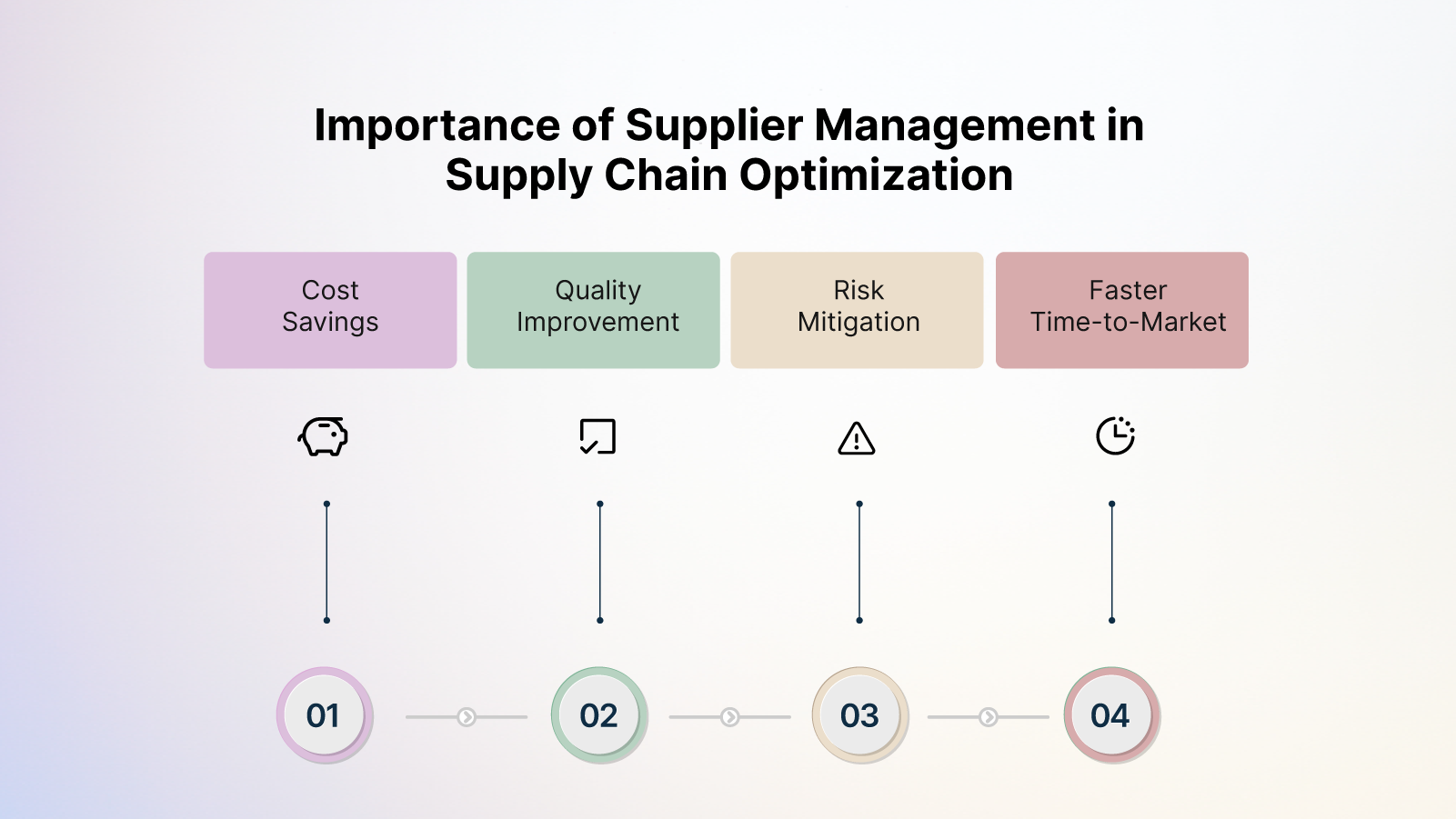
Effective supplier management delivers significant benefits:
1. Cost Savings:
By consolidating spend with fewer strategic suppliers, companies can negotiate better prices, terms, and rebates. Streamlining procurement processes and integrating systems also reduces transaction costs.
2. Quality Improvement:
Suppliers have a direct impact on the quality of a company's products and services. By setting clear quality specifications, monitoring supplier processes, and collaborating on root cause analysis and corrective actions, companies can reduce defects, rework, and customer complaints.
3. Risk Mitigation:
Supply chain disruptions can have devastating consequences, from production delays to reputational damage. Effective supplier management identifies and mitigates risks proactively. This includes assessing supplier financial health, capacity, and business continuity plans, as well as developing alternative sources and contingency plans.
4. Faster Time-to-Market:
Streamlining procurement processes, integrating systems with key suppliers, and implementing just-in-time delivery can significantly reduce lead times and improve responsiveness to customer demands.
To realize these benefits, companies need a systematic approach to supplier management that includes clear policies, processes, and performance metrics. They also need to invest in skilled talent, enabling technologies, and strong governance to drive execution and continuous improvement.
Risks and Challenges in Supplier Management
While the benefits of effective supplier management are significant, it's not without risks and challenges. Here are some common pitfalls that companies must navigate:
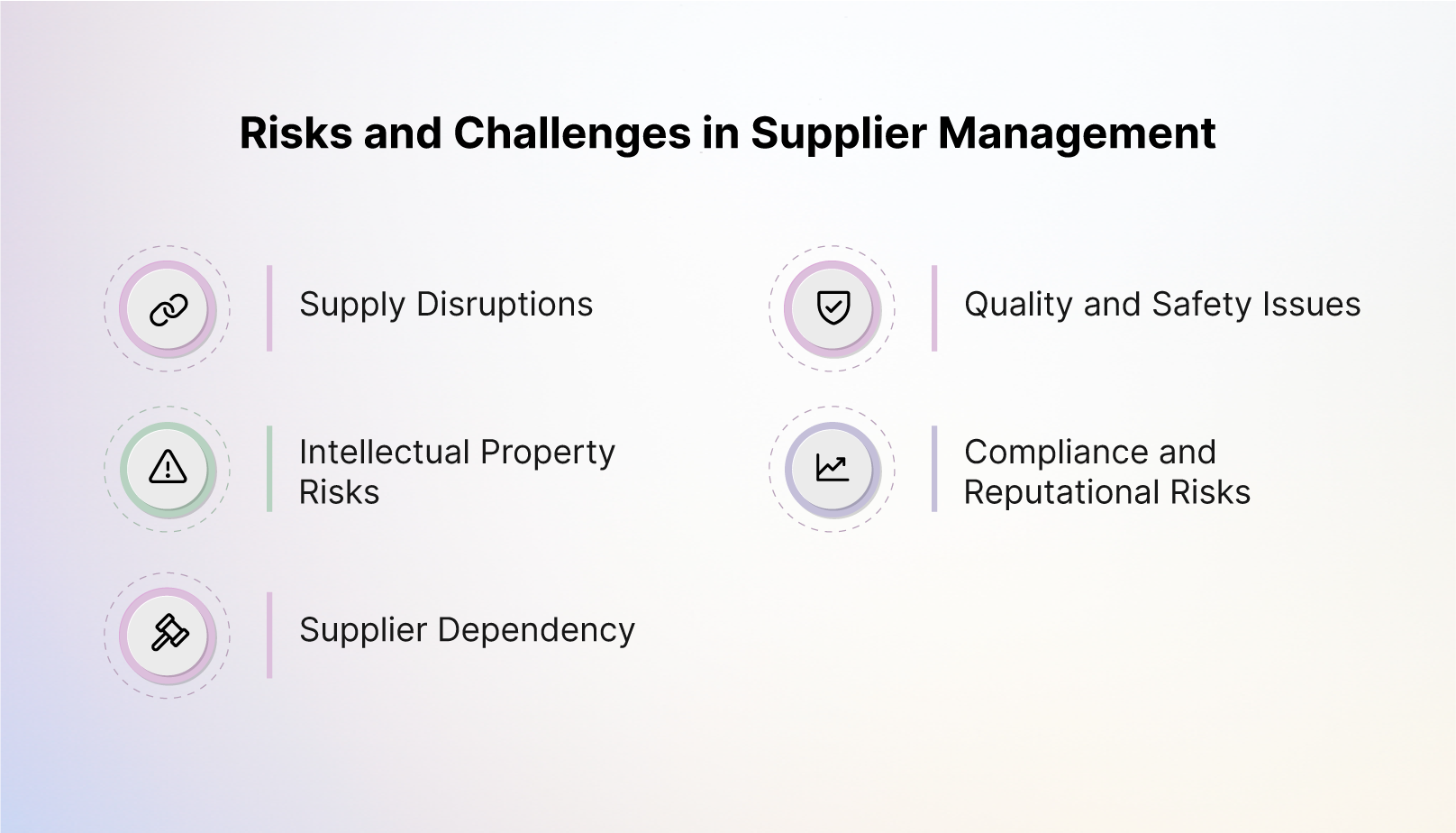
1. Supply Disruptions:
Even with the best planning and risk mitigation strategies, unexpected events can disrupt the flow of goods and services. Natural disasters, geopolitical events, labor strikes, supplier financial distress, and transportation breakdowns are just some of the many potential causes. Companies need business continuity plans and real-time visibility to detect and respond to disruptions quickly.
2. Quality and Safety Issues:
Suppliers that fail to meet quality and safety standards can result in costly recalls, warranty claims, legal liabilities, and damage to brand reputation. Companies must have rigorous supplier quality management systems, including audits, inspections, and traceability, to ensure consistent and compliant performance.
3. Intellectual Property Risks:
When suppliers are involved in product development or have access to sensitive data, there is a risk of intellectual property theft or leakage. Companies need strong non-disclosure agreements, data security protocols, and monitoring systems to protect their intellectual assets.
4. Compliance and Reputational Risks:
Suppliers that engage in unethical, illegal, or unsustainable practices can expose companies to regulatory penalties, legal liabilities, and reputational damage. Companies must conduct thorough due diligence on suppliers' compliance with laws, regulations, and social responsibility standards, and have zero tolerance for violations.
5. Supplier Dependency:
Relying too heavily on a single supplier can create significant risks if that supplier fails to perform or goes out of business. Companies need to diversify their supply base and develop alternative sources to mitigate concentration risk.
To mitigate these risks and challenges, companies need a proactive and holistic approach to supplier management. This includes robust risk assessment and monitoring, clear performance expectations and accountability, open communication and collaboration, and continuous improvement and innovation.
Best Practices for Managing Supplier Relationships
Effective supplier management is not just about transactions and contracts. It's about building trust, transparency, and mutual value with strategic partners. Here are some best practices for managing supplier relationships:
1. Segment suppliers based on strategic importance and risk:
Not all suppliers are created equal. Companies should prioritize their efforts and resources on the suppliers that have the greatest impact on their business. This involves analyzing spend data, assessing supplier capabilities and risks, and categorizing suppliers into segments such as strategic, preferred, transactional, and high-risk.
2. Establish clear performance expectations and metrics:
Suppliers need to know what is expected of them in terms of quality, delivery, cost, innovation, and sustainability. Companies should set specific, measurable, achievable, relevant, and time-bound (SMART) goals and key performance indicators (KPIs) for each supplier, aligned with overall business objectives. These should be documented in contracts, service level agreements (SLAs), and supplier scorecards.
3. Foster open and frequent communication:
Regular communication is essential for building trust and alignment with suppliers. Companies should establish clear points of contact, communication channels, and meeting cadences for each supplier. This can include quarterly business reviews, joint planning sessions, and performance feedback. The tone should be one of partnership and collaboration, not just compliance and control.
4. Monitor and manage supplier risks proactively:
Supplier risks can come from many sources, including financial instability, capacity constraints, cybersecurity threats, and ESG issues. Companies need a robust supplier risk management process that includes ongoing monitoring, scenario planning, and mitigation actions. This can involve using third-party risk management tools, conducting supplier audits and assessments, and having contingency plans in place.
To build a high-performing supplier base that is agile, resilient, and value-creating, it requires a shift from a transactional mindset to a collaborative one, and a willingness to invest in the people, processes, and technologies that enable effective supplier relationship management.
Financial Implications and Considerations in Procurement
Procurement has a direct and significant impact on a company's financial performance. How well a company manages its spend, suppliers, and contracts can be the difference between profitability and loss.
Here are some key financial implications and considerations in procurement:
1. Working Capital Optimization:
Procurement can also have a significant impact on a company's working capital, which is the difference between current assets and current liabilities. By negotiating favorable payment terms with suppliers, optimizing inventory levels, and reducing lead times, procurement can help improve cash flow and reduce the amount of capital tied up in the supply chain.
2. Risk Management:
Supply chain disruptions and supplier failures can have significant financial consequences, from lost sales and market share to increased costs and legal liabilities. Effective procurement risk management, including supplier diversification, business continuity planning, and insurance, can help mitigate these risks and protect the company's financial stability.
3. Compliance and Governance:
Procurement is subject to a wide range of laws, regulations, and standards, from anti-bribery and corruption to data privacy and environmental protection. Non-compliance can result in significant financial penalties, legal liabilities, and reputational damage. Procurement must have robust compliance and governance processes in place to ensure adherence to internal policies and external requirements.
4. Supplier Financial Health:
The financial health of suppliers is a critical consideration for procurement. Suppliers that are financially unstable or over-leveraged can pose significant risks to the supply chain, from quality and delivery issues to bankruptcy and disruption. Procurement must conduct regular financial assessments of key suppliers and have contingency plans in place for supplier failures.
To effectively manage these financial implications and considerations, procurement needs to work closely with finance, accounting, and other stakeholders. This requires a common language, shared metrics, and integrated systems and processes. It also requires procurement professionals to have a strong understanding of financial concepts, analysis, and decision-making.
How Spendflo Can Help with Procurement and Supplier Management
Managing procurement and supplier relationships effectively requires the right tools, processes, and expertise. That's where Spendflo comes in. Spendflo is a leading procurement and supplier management platform that empowers enterprises to optimize spend, mitigate risk, and drive innovation.
Here are some of the key features and benefits of Spendflo:
- A centralized and real-time view of spend data across categories, suppliers, and business units.
- Streamlining the end-to-end sourcing process, from identifying opportunities and building requirements to running RFPs and auctions and awarding contracts. It also provides an intuitive and user-friendly e-procurement platform for employees to find, request, and order goods and services from approved suppliers and catalogs.
- Spendflo enables companies to monitor and manage supplier performance in real-time, based on predefined KPIs and SLAs. It provides a 360-degree view of each supplier, including scorecards, ratings, and feedback from internal stakeholders and external sources.
- A centralized repository for all supplier contracts, with automated workflows for review, approval, and signature. It also enables contract compliance monitoring, with alerts and notifications for expiring contracts, price discrepancies, and SLA breaches. This helps companies reduce risk, improve governance, and optimize contract value.
Curious? Talk to our procurement experts now!
Frequently Asked Questions on Procurement and Supply management
What is the difference between procurement and vendor management?
Procurement focuses on the strategic process of sourcing, selecting, and acquiring goods and services from suppliers. Vendor management, on the other hand, involves building and maintaining relationships with suppliers, monitoring their performance, and ensuring they meet the organization's standards and requirements.
What is the role of supplier management?
Supplier management is responsible for establishing and nurturing productive relationships with an organization's suppliers. This involves evaluating supplier performance, managing contracts, mitigating risks, and collaborating with suppliers to drive continuous improvement and innovation.
What is an example of supplier management?
An example of supplier management is conducting regular performance reviews with key suppliers to assess their quality, delivery, and cost metrics. This may involve setting up meetings to discuss areas for improvement, negotiating better terms, and working together to implement solutions that benefit both the organization and the supplier.
What is Procurement and Supplier Management in a nutshell?
Procurement is the critical function within an organization that involves strategically identifying, evaluating, and selecting suppliers to source and acquire essential goods and services, ensuring optimal value and alignment with business objectives.














.png)










.avif)





